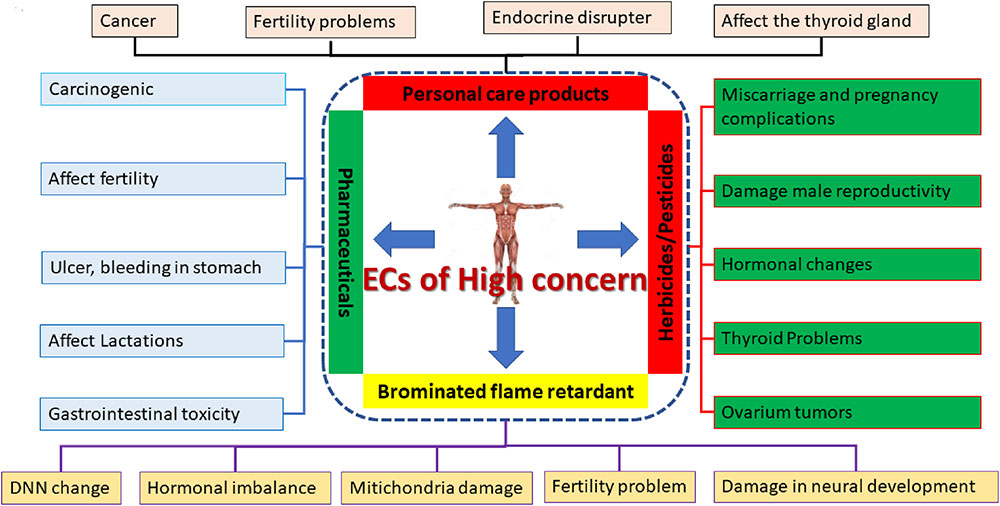Advances in healthcare bring convenience and improved health, but also generated a new threat: the contamination of water resources with pharmaceutical and personal care product (PPCP) residues. Emerging contaminants (ECs) in water resources pose ever-increasing risks to public health and toxic effects on organisms in a natural environment. ECs include synthetic or naturally occurring chemicals and microorganisms that are not commonly monitored but have the potential to enter the natural environment and eventually become a risk to public health. ECs, in general, are known to act as endocrine disruptors – mimic, block, or interfere with the body’s hormones and have deleterious effects on our endocrine systems. For example, one of the common groups of ECs referred to as forever chemicals – Polyfluoroalkyl Substances (PFAS), have been implicated in many serious health effects, including cancer, high blood pressure, and developmental problems in children across the USA. This article aims to provide an overview of emerging contaminants, and their potential sources in Bhutan.

The presence of emerging contaminants in water resources is a major concern for both human health and the environment. Thus, identifying the presence of emerging contaminants in drinking water and evaluating the risks associated with them are paramount so that appropriate measures can be taken to ensure the safety of drinking water for consumers. Further, monitoring of emerging contaminants in drinking water is critical because these contaminants are omnipresent in water resources worldwide.
The prominent classes of ECs include pharmaceuticals and personal care products (PPCPs), plasticizers, surfactants, fire retardants, nanomaterials, and pesticides. Primary sources of ECs include municipal sewage, industrial wastewater, landfill sites, and agricultural runoff. While diffuse sources of ECs include stormwater runoff, and surface runoff from – roads, metropolitan areas, highways, and agricultural land. Landfill sites, where various waste materials including PPCPs are disposed of, can also be a major source of PPCPs. Agricultural runoff, which includes the runoff from fields where pesticides and other agricultural chemicals are used, can introduce PPCPs into the environment. Agricultural runoff in Bhutan may not be a big concern as of today but we do not have adequate baseline data to validate the concern regarding ECs. Improper disposal of unused medications by individuals, such as flushing them down the toilet or throwing them in the trash, can also contribute to the presence of PPCPs in water bodies. Conventional wastewater treatment techniques are insufficient to completely remove ECs; requiring physical, chemical, and biological treatment technologies. The current wastewater treatment plants across Bhutan are not equipped to deal with the EC.
Chemical treatment techniques and advanced oxidation processes have shown high ECs removal efficiencies, while membrane technology can effectively eliminate particles and colloidal particles. Advanced and hybrid treatments, such as a Photo-Fenton Method based on ultraviolet radiation, are necessary for efficiently removing emerging contaminants (ECs) like beta-blockers and pharmaceuticals; a combination of treatments is more effective than single techniques, and existing treatment techniques can be modified through approaches like nanotechnology and genetic engineering to enhance their removal capacities and efficiencies. Various effective treatment techniques include – membrane technology, such as reverse osmosis, ultrafiltration, and nanofiltration, which can effectively remove ECs from water. All those effective technologies to remove ECs in wastewater are almost non-existent in any of the water treatment plants in Bhutan.
While the risks of ECs to Bhutanese people are omnipresent, the technologies available to combat EC in Bhutan are almost non-existent. Further, as of today, Bhutan does not have any baseline data on ECs. Going forward we propose to invest in research on ECs and then develop appropriate management strategies for ECs management both for drinking water treatment and wastewater treatment plants. The long-term management strategies need to be supported with appropriate legal frameworks to protect both public health and the natural environment.
Based on recent research publications, Kumar et al. (2022) summarize threats of EC to public health. ECs pose a substantial risk to humans, even in a trace amount!
The article is published based on personal experiences and observations by a group of water researchers from Bhutan www.waterresearchbhutan.org

